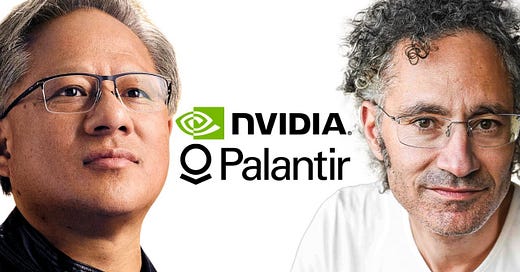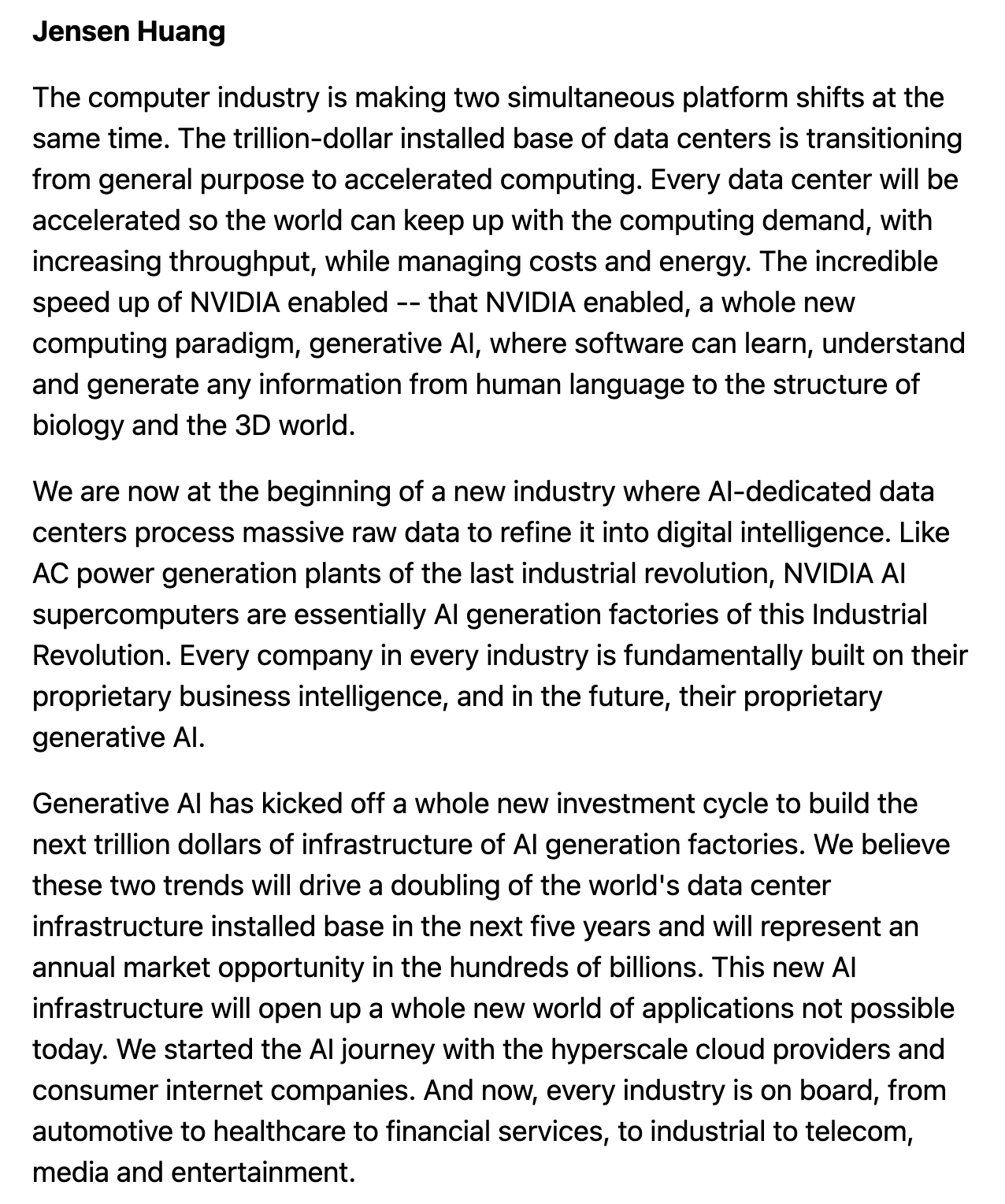NVDA crushes earnings...and helps Palantir?
Let's break down the future of AI demand for NVDA + PLTR
Welcome back to DailyPalantir! On today’s newsletter, we’re breaking down NVDA’s numbers and what they mean for Palantir and the future of AI. Let’s get into it.
Nvidia had one of the most fascinating, mind-blowing quarters a public company could ever have.
The broader markets were down about 3% on the simple perception that Nvidia may disappoint hours before they reported.
They did not disappoint, their market cap rose $300B over two days (the largest ever seen in the history of the stock market) and the entire market rose to an all time high. One company was responsible for this.
Couple things on their quarter that you should know, especially if you own Palantir, because it will help contextualize what is going on in the entire AI space:
Record quarterly revenue of $22.1 billion, up 22% from Q3, up 265% from year ago
Record quarterly Data Center revenue of $18.4 billion, up 27% from Q3, up 409% from year ago
Record full-year revenue of $60.9 billion, up 126%
These numbers are insane. Not to mention, China used to be 25% of their overall sales, but then in October, the US banned NVDA from selling to China. Their sales went from 25% to 1%…and they still beat on earnings. It hurts to imagine what their numbers would be like if they hadn’t cooperated with the US government.
Okay, so why did this give a boost to the entire market?
Well, let’s let Jensen explain from the earnings call…
The basic argument he is trying to make is that Generative AI & Accelerated Computing are at their infant stages — which is hard to believe given the numbers that Nvidia is putting up, but it is true.
If that’s the case, there will only be more demand and growth for the broader AI sector, which is why so many analysts, like Dan Ives, feel this is closer to 1995 than 1999.
What does it mean for Palantir?
The increased demand for Nvidia's GPUs is a positive indicator for Palantir because it reflects a broader trend of growth in the AI and data analytics sectors, areas where Palantir's platforms are extensively used. Nvidia's GPUs are critical for processing large datasets and running complex machine learning algorithms efficiently, which are core capabilities for AI applications. As more organizations invest in AI technology, the need for powerful data analytics platforms like those offered by Palantir also rises.
Palantir's AI-powered platform, AIP (Artificial Intelligence Platform), is designed to leverage advancements in AI for data analysis and decision-making processes. The surge in Nvidia's GPU demand suggests that more companies are undertaking AI initiatives that require the kind of sophisticated data integration and analysis that Palantir provides. This creates a larger potential customer base for Palantir's services, as organizations seek to turn their increased computational power into actionable insights.
Jensen on why GPU demand is only growing:
So, as Nvidia continues to innovate and provide more advanced GPUs, Palantir can harness these improvements to enhance its own offerings. Better hardware allows Palantir's software to perform more efficiently and handle more complex tasks, which can lead to new features and capabilities within their platforms. This symbiotic relationship between hardware and software in the AI space means that advancements in one area can drive progress in the other.
Nvidia's GPUs are essential for AI and machine learning tasks, which are integral to Palantir's platforms.
Increased GPU demand indicates a growing market for AI technologies, benefiting Palantir's business.
More companies investing in AI will likely seek out Palantir's data analytics capabilities.
Advancements in Nvidia's GPU technology can lead to improvements in Palantir's software performance.
The relationship between hardware capability and software applications in AI is symbiotic.
So, the rising demand for Nvidia's GPUs is a positive sign for Palantir as it indicates a growing interest and investment in AI technologies.
This trend can lead to an expanded customer base for Palantir's AI-powered platforms and services. Additionally, improvements in GPU technology can enhance the performance and capabilities of Palantir's software, allowing the company to offer more advanced solutions to its clients.
Palantir got a small bump on NVDA earnings by about 5%, and then lost that the next day. NVDA continued to maintain their gains, and it seems like the street realized that what Jensen has been saying is true.
Now, why did the broader market rally off one stock doing well?
The way I see it, AI increases productivity, operating margins, and revenue for companies that implement it correctly. It also decreases costs.
This is important for public companies because if they decrease their costs and increase their revenues, their earnings should do better, and as a result, investors should buy their stocks.
So, seeing the entire market go up last week on NVDA earnings was more of a testament to the confidence investors have that if GPU demand (read: AI demand) continues to surge, we eventually will see the increase in productivity at such a scale that every company, whether a healthcare company or logistics company, will get more efficient and produce better results.
Palantir sits in the middle of all those companies doing better and NVDA’s massive GPU demand. Just because there is more data center demand does not mean there will just be companies increasing productivity — software will be needed to operationalize the data those companies have (read: AIP) in order for those companies to figure out how to even begin streamlining their business processes and entering into the age of advanced data-driven decision making.
So, Nvidia is showing the market that there is massive demand for AI. Palantir is set, in my opinion, to capitalize on that demand because companies will need something like an AIP+Foundry in order to implement software that actually operationalizes AI within their enterprise.
It’s a massive, massive market. Nvidia just showed us the market is only growing.
That’s it for today — I’ll see you tomorrow in your inbox!








Party!